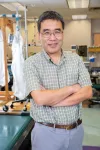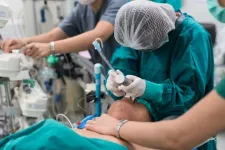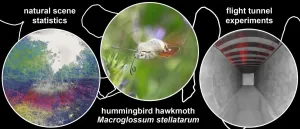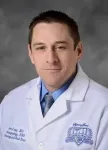(Press-News.org) Many organisms use sunlight to fuel cellular functions. But exactly how does this conversion of solar energy into chemical energy unfold?
In a recent experiment, an international team of scientists, including two researchers from UWM, sought answers using an advanced imaging technique called time-resolved serial femtosecond crystallography to watch a pigment found in some marine bacteria as it was exposed to sunlight outside the cell.
For this experiment, the researchers documented, for the first time, the dynamics of the "chloride ion-pumping rhodopsin," an atomic "pump," which is jump-started by sunlight and moves chloride ions unidirectionally into the bacterial cells.
These pumps may also serve as a kind of molecular solar cell for energy conversion.
Once inside, the chloride ions create a negatively charged environment, while the outside of the cell remains neutral. This results in an electric field that the bacteria could use to move, grow and maintain other vital functions.
The imaging method is capable of capturing sequential pictures of the molecular changes of biological macromolecules at work.
How chloride is pumped and transported within the rhodopsin has been elusive, said Marius Schmidt, UWM professor of physics who is one of the corresponding authors on the paper, which appeared March 22 in the journal Proceedings of the National Academy of Sciences. Recent UWM graduate and postdoctoral researcher Suraj Pandey also contributed substantially to this research.
"We intended to find out how sunlight drives the pump," Schmidt said. "The rhodopsin's response to light starts the mechanism. The response is extremely fast - at picoseconds, a trillionth of a second. So, we needed to make a molecular movie on extremely fast time scales to follow the 'pumping' action."
The movie shows both the mechanics of the pump and the movements of the pump's piston in a cylinder, which displaces the chloride ions. The size of this piston, however, is one billion times smaller than a piston in the macroscopic world. The movie shows in atomic detail how the piston pushes the chloride ions into the bacterial cell.
Imaging was done with Free Electron Laser (XFEL) equipment at the Linac Coherent Light Source in California that uses ultra-short and intense X-ray pulses that repeat rapidly to capture the frames of the molecular movie. X-rays hit protein molecules that are located in tiny crystals and which diffract into certain patterns, revealing where the atoms are at a single instance of time.
With so many pulses per second, the equipment's camera can work at blistering speed, churning out a multitude of "snapshots." Those are then mathematically reconstructed into 3D moving images that depict the arrangement of atoms over time - the structural changes that occur when proteins accomplish a task.
The work is relatable to human biology, he said, because the structure of the chloride pump is very similar to the rhodopsin and the photopsins in the human eye. While it doesn't pump chloride, rhodopsin enables the human eye to absorb light and convert it into the generation of electrical signals that communicate with the brain.
The structure of this chloride-ion pump also resembles that of other G-protein coupled receptors (GPCRs) in humans, which regulate functions such as blood pressure and hormone management. GPRCs are of interest to the pharmaceutical industry because they are prime drug targets.
Although the imaging is being used to advance fundamental biological science, this mechanism could also be applied in the future, Schmidt said, to design light-sensitive molecular pumps. "The chloride pump could be inserted into other organisms, and you'd be able to manipulate their behavior with light through a method called optogenetics," he said.
INFORMATION:
In addition to the UWM researchers, other members of the scientific team on the paper include researchers from Yonsei University in South Korea, Beijing Computational Science Research Center in China, Tsinghua University in China, Beijing Normal University in China, Arizona State University, Linac Coherent Light Source, La Trobe University in Australia, and Yokohama City University in Japan.
The work at UWM was funded by the National Science Foundation through the BioXFEL Science and Technology Center.
DALLAS - March 23, 2021 - It's not just your legs and heart that get a workout when you walk briskly; exercise affects your brain as well. A new study by researchers at UT Southwestern shows that when older adults with mild memory loss followed an exercise program for a year, the blood flow to their brains increased. The results were published online today in the Journal of Alzheimer's Disease.
"This is part of a growing body of evidence linking exercise with brain health," says study leader Rong Zhang, Ph.D., professor of neurology at UTSW. "We've shown for the first time in a randomized ...
A study of ancient bones shows that Early Neolithic sheep-breeders were faced with high levels of mortality among young animals in their herds. A statistical model, partly developed at Ludwig-Maximilians-Universitaet (LMU) in Munich, allowed the age distribution of the bones to be precisely determined.
In the 8th millennium BCE, early sheep-herders were already aware that the conditions under which their animals were housed had an impact on mortality rates among the lambs. This one result of a study researchers led by Nadja Pöllath (a curator at the State Collection for Anthropology and Palaeoanatomy in Munich), LMU zooarchaeologist Joris Peters (who is also the Director of the state collection) ...
The BioRescue consortium develops and applies new technological approaches as a last straw for saving critically endangered species such as the northern white rhinoceros. Advanced Assisted Reproductive Technologies (aART) push the boundaries of what can be done to create new offspring. Consequently, new ethical questions regarding the application of these tools arise and need to be answered, and relevant animal welfare issues to be addressed. In order to ensure that the ethical risk assessment matches the technological breakthrough with aART, the BioRescue ...
Despite guidelines promoting outpatient management of patients with low-risk pulmonary embolism (PE), few patients are currently discharged home from hospital emergency departments in the United States. That is the conclusion of a study titled Outpatient Management of Patients Following Diagnosis of Acute Pulmonary Embolism, published in the March 2021 issue of Academic Emergency Medicine (AEM), a journal of the Society for Academic Emergency Medicine (SAEM).
The retrospective cohort study of more than 61,000 patients treated at 740 acute care United States emergency departments during a two-year period sought to determine disposition practices and subsequent health care utilization in patients with acute PE. According to the findings, ...
A study co-authored by researchers at the Johns Hopkins Bloomberg School of Public Health found that telehealth consults among privately insured working-age patients accounted for almost 24 percent of outpatient consults with health care providers during the early phase of the pandemic, March to June 2020, up from less than 0.3 percent during the same period in 2019.
The dramatic shift occurred as many medical practices halted or curtailed in-person office hours and patients stayed away from doctor's offices out of fear of transmission during the early months of the pandemic. At the same time, insurance companies and the federal government relaxed policies around telehealth to meet demand for remote medical consults ...
Most people relate cholesterol to heart health, but it is also a critical component in the growth and spread of brain cancer. VCU Massey Cancer Center researcher Suyun Huang, Ph.D., recently discovered how cholesterol becomes dysregulated in brain cancer cells and showed that the gene responsible for it could be a target for future drugs.
The mean survival of patients with the most common and aggressive type of brain cancer, glioblastoma multiforme (GBM), is 14 months. The need to find new, effective treatments is urgent and has driven Huang, a member of the Cancer Biology research program at Massey, to detail ...
Some 40% of critically ill patients who undergo tracheal intubation to support their breathing suffer a life-threatening complication, research from National University of Ireland Galway has revealed.
The study, published today in JAMA: The Journal of the American Medical Association, involved 2,964 critically ill men and women. It was carried out across 29 countries from 1 October 2018 to 31 July 2019 to determine the risk of adverse events arising from the invasive procedure.
John Laffey, Professor of Intensive Care Medicine at NUI Galway and Consultant in ...
HOUSTON - (March 23, 2021) - Fish that dine on corals may pay it forward with poop.
It's an unexpected twist on coral reef symbiosis, said Rice University marine biologist Adrienne Correa, whose lab discovered coral predator feces are jam-packed with living symbiotic algae that corals depend on for survival. The discovery confirms that poop from coral-eating fish is an important environmental source of symbiotic dinoflagellate algae on coral reefs.
Correa said coral-eating predators are typically thought of as biting and weakening reef structures, thereby generating hiding spaces for other organisms and, ultimately, beach sand. In contrast, grazing fish that crop down bushy algae get the limelight for helping reefs maintain healthy coral ...
Hummingbird hawkmoths are small insects that hover in the air like hummingbirds when drinking nectar from flowers. Dr. Anna Stöckl from the Biocentre of the Julius-Maximilians-Universität (JMU) Würzburg in Bavaria, Germany, is studying the visual performance of these insects. Dr. Stöckl and her doctoral student Ronja Bigge now present their latest findings in the journal Current Biology.
"To control their flight, hummingbird hawkmoths rely on optic flow in the lower half of their visual field," Ronja Bigge explains. Optic flow is the relative motion that the surrounding image casts on the animals' retinas when they fly. We experience this phenomenon ourselves when travelling by train ...
DETROIT (March, 23, 2021) - Henry Ford physician, John Craig, M.D., is leading an international research effort to improve the multidisciplinary collaboration between otolaryngologists and dental providers around the globe when it comes to diagnosing odontogenic sinusitis (ODS).
ODS is an infectious condition of the paranasal sinuses that can occur from either dental infection or dental procedures involving the upper jaw. There are multiple ways that infection can spread from the teeth to sinuses, and in more severe scenarios, to the eye, brain, or rest of the body. It has been shown that the various clinicians ...





